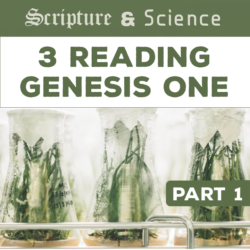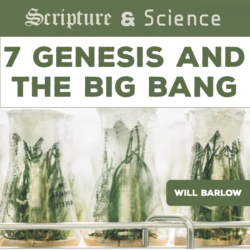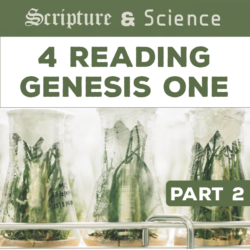Today we are going to cover gap theories and John Walton’s temple idea. Will Barlow explains how gap theories work, including the classic idea that there’s a gap of billions of years between Genesis 1.1 and 1.2 as well as the modified version. After explaining the pros and cons for these views, he briefly explains John Walton’s theory that Genesis 1 solely focuses on function not physical creation.
Listen to this episode on Spotify or Apple Podcasts
See below for notes.
—— Links ——
- We are doing follow-up discussions to these episodes on YouTube. Check them out!
- See other episodes in this Scripture and Science Class
- Check out Barlow’s previous podcast episodes
- Learn more about and support the church Barlow and his team are starting in Louisville, KY, called Compass Christian Church
- Find more articles and audios by Barlow on his website: Study Driven Faith
- Check out the early Christian quotes about the Hebrew version of the Gospel of Matthew here
- Support Restitutio by donating here
- Designate Restitutio as your charity of choice for Amazon purchases
- Join our Restitutio Facebook Group and follow Sean Finnegan on Twitter @RestitutioSF
- Leave a voice message via SpeakPipe with questions or comments and we may play them out on the air
- Intro music: Good Vibes by MBB Attribution-ShareAlike 3.0 Unported (CC BY-SA 3.0) Free Download / Stream: Music promoted by Audio Library.
- Who is Sean Finnegan? Read his bio here
—— Notes ——
Gap Theory
There are various versions of Gap Theory:
• Standard – multiple options here
• Modified (“Preparing the Garden”)
Pros of Standard Gap Theory
Here are some pros with the standard formulation of Gap Theory:
• It takes the word “day” literally as a 24-hour period
• It fits directly with scientific evidence for an old Earth
• It looks to the text (both in Genesis 1 and remote texts) to reach conclusions
Internal Evidence
Genesis 1:2 The earth was [or became] without form and void, and darkness was over the face of the deep. And the Spirit of God was hovering over the face of the waters.
“Was” or “became”?
• Generally, in Hebrew, the verb “was” is unnecessary when talking about simple existence
Genesis 23:17 So the field of Ephron in Machpelah, which was to the east of Mamre, the field with the cave that was in it and all the trees that were in the field, throughout its whole area, was made over
“Was” or “became”?
• Some scholars suggest that the verb is needed for the past tense, but here is a counterexample:
Genesis 41:12a A young Hebrew was [not in Hebrew] there with us, a servant of the captain of the guard.
• So, some scholars believe that when the verb “was” is there, it takes on a more specific meaning: “become”
• In other words, the word “was” takes on a meaning denoting change, not simple existence
How did God create?
Genesis 1:2 The earth was without form and void, and darkness was over the face of the deep. And the Spirit of God was hovering over the face of the waters.
Compare with Jeremiah 4:23-26, Isaiah 34:11, Isaiah 45:18-19, among others
Terms Used in Genesis
• Genesis 1:5 “God called the light day”
• Genesis 1:5 “God called the darkness night”
• Genesis 1:8 “God called the expanse heaven”
• Genesis 1:10 “God called the dry ground land”
• Genesis 1:10 “God called the waters seas”
Genesis 1:16 And God made the two great lights–the greater light to rule the day and the lesser light to rule the night–and the stars.
The word “made” does not generally mean “create.” In this context, it can be understood as God working on His creation.
Genesis 1:17 And God set them in the expanse of the heavens to give light on the earth,
The word “set” can mean “appoint, designate, assign.” In this context, it can be understood as God providing a purpose for the stars, not the original creation.
Is Gap Theory a recent invention?
Detractors of Gap Theory say that it became popular after scientific evidence for an old Earth came in vogue around 200 years ago.
• Jewish sources throughout time lend credence to the Gap interpretation
• Ancient Christian sources, including Thomas Aquinas, mentioned the possibility of a gap
Problems with Standard Gap Theory
Here are some problems with the standard formulation of Gap Theory:
• Gives Satan too much power
• Grammatical concerns over “was”
• There is no scientific evidence for a reconstituted heaven and Earth
• Contextual concerns with Jeremiah 4 and Isaiah 34
• Genesis 1:28 says “fill,” not “replenish”
Modified Gap Theory
Modified Gap Theory holds that:
• Genesis 1:1 refers to the beginning of creation
• Genesis 1:2 focuses on God putting order into the wasteland, preparing the garden
• Nothing in Genesis 1:2ff is talking about creation but rather about shaping the garden and the promised land
Views Compatible with Either
• The “God’s Temple” interpretation — John Walton
• Any non-literal interpretation that does not involve evolution
Walton’s “Temple” Interpretation
Walton’s view is based on 18 separate propositions. Proposition 1: Genesis 1 is ancient cosmology.
“So if God aligned revelation with one particular science, it would have been unintelligible to people who lived prior to the time of that science, and it would be obsolete to those who live after that time…”
“We gain nothing by bringing God’s revelation into accordance with today’s science. In contrast, it makes perfect sense that God communicated his revelation to his immediate audience in terms they understood.” (pg. 15)
Giving an analogy from the ancient view of the liver, kidneys, and intestines:
“Yet we must notice that when God wanted to talk to the Israelites about their intellect, emotions, and will, he did not revise their ideas of physiology and feel compelled to reveal the function of the brain. Instead, he adopted the language of the culture to communicate in terms they understood.” (pg. 16)
Proposition 2: Ancient Cosmology is Function Oriented
“Even staying in the realm of English usage we can see that we don’t always use the verb create in material terms. When we create a committee, create a curriculum, create havoc or create a masterpiece, we are not involved in a material manufacturing process.” (pg. 23)
“In this book I propose that people in the ancient world believed that something existed not by virtue of its material properties, but by virtue of its having a function in an ordered system.” (pg. 24)
Walton believes that God’s Temple is the heavens and the earth (Isaiah 66:1-2). Thus, the six-day creation account is not a scientific depiction of the creation of the Universe, but rather a description of God setting up his Temple and putting it in order.
Parallels between Genesis 1 and other Temple accounts:
• Seven day consecration of tabernacle in Exodus 39-40
• Seven-year construction of Solomon’s Temple, followed by a seven-day dedication feast (1 Kings 6)
• Description of Eden and the Temple have some similarities
Bottom line:
• Wants to interpret Genesis 1 in light of Ancient Near East culture and scientific understanding
• Gives a context for the text that focuses on God’s relationship with Israel, not with the creation of physical matter and space
Problems with Walton’s “Temple” View
Here are some problems with the “Temple” view:
• Atheists love to attack non-literal readings, since it shows that Jews and Christians can “pick and choose.”
• There is no clear evidence that anyone has held this specific view at any point in Judeo-Christian history.
• It leaves many questions unanswered, especially relating to science.
How should we read Genesis 1?
• Remember who the original audience was (coming out of slavery, coming out of idolatry)
• Consider the text and the various options to interpret it
• Consider the scientific evidence and how much weight you want to give it
Resources
• Young Earth Creationism (Answers in Genesis, Institute for Creation Research, The Genesis Flood by Morris and Whitcomb)
• Day-Age (Hugh Ross, Gerald Schoeder)
• Gap Theory (Arthur Custance, Jack Langford)
• Temple (John Walton)






